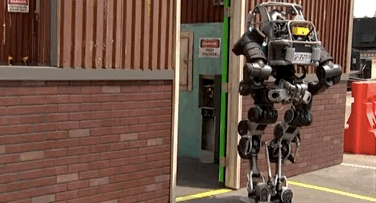These robots aren’t here to kill you, and even if they were, they would just fall down

Minor spoiler alert: Alex Garland’s film, Ex Machina, which is set in the near-ish future, does not end well for humans. It does, however, end quite well for the pairing of robots and AI. This outcome augurs poorly for humanity (or at least men), but is it indicative of where robotics is headed?
In the wake of Japan’s Fukushima reactor meltdown, this year’s DARPA Robotics Challenge tasked teams with building robots capable of assisting humans during disaster relief missions. The main event was last weekend, and the results weren’t altogether encouraging. Here, for instance, is a compilation of robots falling over that Sploid helpfully set to the Benny Hill theme:
Had a good laugh? Good. Let’s see if there’s anything else to this story.
It seems safe to say that the Ex Machina scenario—death by humanoid robot—is not imminent. As Jun Ho Oh, the leader of the winning team and a professor at Korea Advanced Institute of Science and Technology, told IEEE Spectrum: “Bipedal walking [for robots] is not very stable yet…One single thing goes wrong, the result is catastrophic.” That explains why all the robots in Sploid’s video are falling over. It also explains why KAIST’s winning entry, while capable of standing on its feet when added height was required, got around by dropping to its knees and using the motorized wheels in its ‘kneecaps’ for propulsion.
“One single thing goes wrong, the result is catastrophic.”
This, broadly speaking, is good news. KAIST’s entry, and indeed many of its rivals, suggests that robots can assist in nuclear disasters, if not other disasters too. Moreover, the design paradigms on display at the DARPA suggest that the robot takeover movies love to traffic in isn’t coming anytime soon. As Carnegie Mellon University’s Tom Stentz told the MIT Technology Review: “The real advancement here is the robots and the humans working together to do something…The robot does what the robot’s good at, and the human does what the human is good at.”



